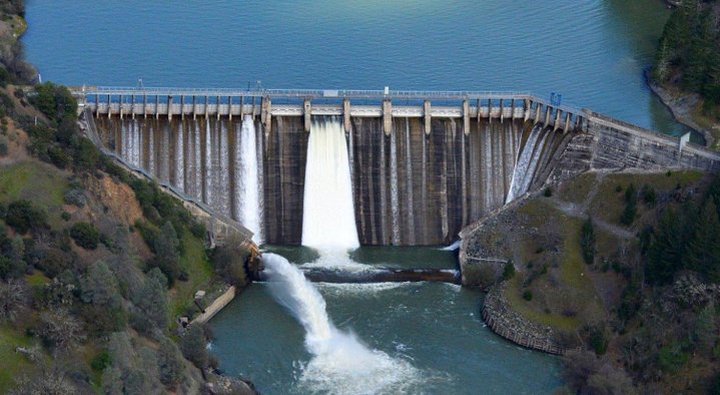
Scott Dam at Lake Pillsbury — a key component of the Potter Valley Project. Photo: PG&E.
###
PREVIOUSLY
- PG&E Tells Regional Commission It’s Thinking About Selling or Abandoning Potter Valley Dams, Which Take Water Out of the Eel and Send It South
- D.C. UPDATE: Rep. Huffman Envisions the Future of the Eel River, Defends His Endorsement of Ryan Sundberg, Trash-Talks the LoCO Commentariat
###
From Friends of the Eel:
Pacific Gas and Electric (PG&E), the utility that owns Scott and Cape Horn Dams on the upper Eel River, announced yesterday that the company is moving to auction the dams to buyers who would want to keep them in place to maintain the diversion of Eel River water into the Russian River.
Friends of the Eel River Conservation Director Scott Greacen said, “We welcome PG&E’s recognition of the fact that the Eel River dams don’t make economic sense, and we’re encouraged the company is moving to accelerate a process that could too easily be subject to almost endless delays. But what’s good for PG&E is not necessarily what’s best for the Eel River or for the region. There’s room to talk, but we really need to talk about removing Scott Dam.”
In its letter to the Eel-Russian River Commission announcing its plans, PG&E states that “the project has key environmental attributes and provides important regional benefits including recreation opportunities and a significant contribution to the Russian River water supply.” Here, PG&E is doing what any rational seller would – seeking the highest possible price for its property by emphasizing its notional benefits, while playing down its many drawbacks. Potential buyers would be wise to carefully investigate these claimed benefits, as well as the costs PG&E is less eager to discuss.
PG&E’s acknowledgment that the Eel River dams are not an economic asset for the company is the most significant fact to emerge from this announcement. If the dams made money, PG&E would be keeping them.
The Eel River dams are in fact not assets, but environmental and economic liabilities. The math on both ledgers is only going to get worse over time. Similarly, while diversions from the Eel River have been convenient for managers of the over-appropriated Russian River, they are very likely to continue to decline in volume, and very unlikely to ever return to the last century’s levels. Though the dams do provide benefits to Russian River interests in the form of water diversions, those benefits pale against significant costs to Eel River fisheries.
PG&E is doing what we expect any American corporation to do – seeking both to protect its shareholders from reasonably foreseeable risks and to maintain the value of its assets over time. Having recognized that the Eel River dams don’t make economic sense as a way to produce electric power, PG&E has suggested that entities interested in both electrical power production and water supply may want to continue operating the dams and diversion to the Russian River.
However, any new owner will have to shoulder the same burdens PG&E has decided are not worth the trouble. These liabilities include the relicensing process now underway before the Federal Energy Regulatory Commission (FERC). A new license is likely to result in additional reductions in the volume of Eel River diversions, as well as substantial costs to comply with mandatory license conditions for fish passage over Scott Dam and water quality protection – not to mention the costs of relicensing itself.
Any potential buyer will also face significant risks and costs associated with dam safety. FERC is refusing to address dam safety issues in relicensing, but that only increases the uncertainty associated with seismic and geotechnical threats, particularly to Scott Dam, which will be a century old when its current license expires in 2022.
PG&E has been investing for years now in geologists’ investigations of the Bartlett Springs Fault, a branch of the San Andreas Fault system which runs only miles east of Scott Dam, but was completely unknown when the dam was built. This work shows the Bartlett Springs Fault is larger and more active than previously thought – and that the area around Gravelly Valley, now the Lake Pillsbury reservoir, shows the most evidence of recent activity along the entire fault. This information only adds to longstanding concerns about the construction of Scott Dam itself and the stability of the southern bank above and behind the dam. We will be interested to see whether potential purchasers will be provided full access to PG&E’s internal assessments of the seismic and geotechnical threats to Scott Dam.
CLICK TO MANAGE